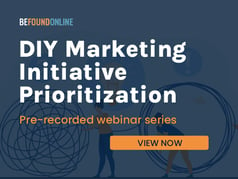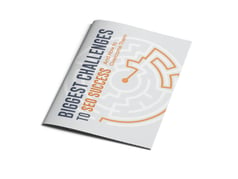Google's Page Experience Signals to be Launched May 2021
January 28, 2021
4 Minute Read

No matter how hard marketing experts try to adjust, Google always has something new in store for them. In May 2021, the search giant is introducing another change in its ranking algorithms. Aiming to improve the user experience even further, Google is launching Core Web Vitals.
These three signals are going to affect the entire SEO (Search Engine Optimization) playing field. With several months still to go, it’s imperative to adjust your website to suit the latest requirements. Otherwise, it’s possible to lose your position on the SERPs (Search Engine Result Pages).
Let’s take a closer look at what Core Web Vitals are all about and what you can do to meet them fully armed.
Core Web Vitals: The Details
Core Web Vitals are a set of three signals that Google considers important for user experience on a website. These signals will become a part of Google’s page experience score, thus having a direct effect on the website’s ranking.
Core Web Vital #1: Largest Contentful Paint (Loading Time)
The period between the start of the page loading process and the time the largest image or text in the visitor’s viewpoint finishes loading. According to Google’s requirements, it should take 2.5 seconds or less for the webpage’s main content to load.
Core Web Vital #2: First Input Delay (Interactivity)
The time it takes for a webpage to be fully ready for the user’s interactivity. It measures how long it takes a page to react to such user’s actions as clicks, scrolls, or input. The ideal time for the page to become interactive is 100 ms or less.
Core Web Vital #3: Cumulative Layout Shift (Stability)
The combination of all layout shifts that aren’t caused by user interaction. The layout shift often happens due to the image loading longer than the text. A user starts reading the text only to see it shift down when the image loads. This interferes with UX tremendously, forcing the visitor to look for the text they were reading before the interruption.
A fully static page without layout shifts has a “0” CLS score. According to Google, the ideal cumulative layout shift (CLS) score should be 0.1 or below.
Core Web Vitals will be combined with the existing page experience factors, such as HTTPS, mobile-friendliness, intrusive interstitials, and safe browsing. Together these seven signals will play a big role in the website ranking process as soon as the May 2021 update rolls out.
How to Check Your Core Web Vitals
If you want to find out how well your webpages are doing so far, you can take advantage of the following tools:
- Google’s PageSpeed Insights.
- Google’s Core Web Vitals Report.
- Chrome User Experience Report
- WebPage Test
- Chrome’s Web Vitals Extension
It’s possible that your website is currently lacking what it takes according to Google’s new UX demands. Thankfully, you still have several months to take care of the issue.
How to Optimize Your Website for Google’s 2021 UX Update
Here are a few things to consider when preparing for the upcoming update.
Rethink Your Hosting
The quality of your web hosting affects the entire user experience from page speed to security. If you are experiencing loading delays, you may want to review the type of hosting you are using.
For example, shared hosting is generally good for small websites only. This update could be the push you needed to switch to cloud, VPS, or dedicated hosting.
Review Advertising Elements
Large pop-ups and banners don’t just slow down your website, they hinder user experience. Anything that interferes with the user’s smooth access to content is a giant red flag for Google.
Sizable banners can affect all three Core Web Vitals negatively. So consider making advertising efforts subtle.
Implement AMP
If you haven’t implemented Google’s Accelerated Mobile Pages (AMP) yet, it’s time to consider it right now. This web publishing framework is aimed at improving user experience on mobile.
AMP continues gaining functionality, reducing the page loading time, improving UX, and increasing conversion rates. Since not all websites are adopting AMP, it’s a good way to get ahead of the competition.
Look Over at the Competition
Even if your Core Web Vitals and other ranking factors are in order, don’t stop improving them. Using the above-mentioned tools, check out how well your competitors are doing. If their UX signals are better than yours, they have a good shot at ranking higher.
Prioritize Top-Ranking Pages
While there is still plenty of time to prepare for the update, it doesn’t mean you should use it to redo your entire website. If after performing an audit, you see that numerous pages need improvement, don’t invest in rebuilding all of them.
Work on pages that have the highest rankings and pages that score below the competition. The rest can be fixed with time. You should also keep the upcoming update in mind when creating new pages.
Focus on Your Content
When it comes to the showdown between user experience and content quality, the latter always wins. No matter how much you can improve UX signals by decreasing content quality, don’t fall into the trap.
According to Google: “we will prioritize pages with the best information overall, even if some aspects of page experience are subpar.”
When Google ranks your website, UX is just one part of the deal. Regardless of the upcoming update, the search engine will continue paying serious attention to the content quality. Even if you have ideal Core Web Vitals, poor content will hurt your rankings tremendously.
The Takeaway
Google’s 2021 page experience update will turn the new UX signals into ranking factors. By preparing for the update right now, you minimize your chances of losing rankings when it rolls out.
Overall, all Google’s efforts are aimed at improving the searcher’s experience. By keeping the same goal in mind when designing your website, it’s possible to stay on top of all ranking algorithm changes in advance.
Do you need professional assistance to prepare your website for the 2021 Page Experience Update? We are always here to help.

Dan Golden
Dan Golden is a veteran digital marketing executive & speaker. He liked to predict the future of digital marketing and is damn good at it. Beyond trendspotting, he has an insatiable desire to know what works and that means spending time auditing accounts, testing tactics, and diving into analytics. Dan is also a Forbes and HuffPost contributor, as well as a Lecturer at Northwestern University and DePaul University.
CATEGORIES
SUBSCRIBE TO OUR BLOG
Stay up to date with the latest industry best practices in digital marketing!























.png?width=339&height=179&name=Webinar%20Banner%20(1).png)



.png?width=339&height=179&name=July%20Webinar%20(Newsletter).png)

.png?width=339&height=179&name=Webinar%20Banner-April-02%20(1).png)
%20(4).png?width=339&height=179&name=Webinar%20Banner-May-02%20(1)%20(4).png)




.png?width=339&height=179&name=March%202023%20Webinar%20Ad%20(autoresponder).png)






























































